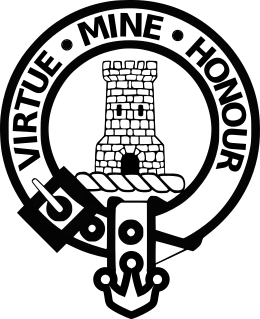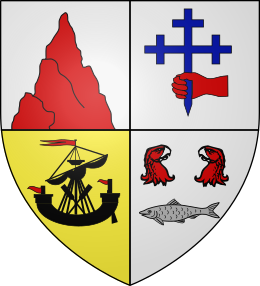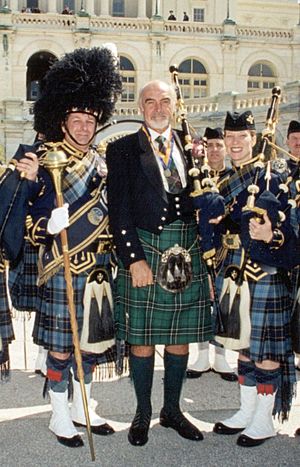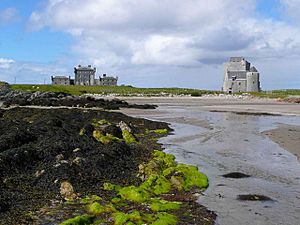Clan Maclean facts for kids
Quick facts for kids Clan Maclean |
|||
|---|---|---|---|
| Clann 'IllEathain, Clann MhicIllEathain, Na Leathanaich | |||

Crest: A tower embattled Argent
|
|||
| Motto | Virtue Mine Honour (My Virtues are my Honour) | ||
| Slogan | Bàs no Beatha ("Death or victory") | ||
| Profile | |||
| Region | Highlands | ||
| District | Inner Hebrides | ||
| Plant badge | crowberry or holly | ||
| Chief | |||
 |
|||
| Lachlan Hector Charles Maclean of Duart and Morven | |||
| The 12th Baronet of Morvern | |||
| Seat | Duart Castle | ||
|
|||
|
|||
|
|||
|
|||
|
|||
Clan Maclean is a historic Highlands Scottish clan. They are one of the oldest clans in the Highlands. They once owned large areas of land in Argyll and the Inner Hebrides. Many early MacLeans were known for their bravery and strength in battle. They were often involved in conflicts with other clans like the Mackinnons, Camerons, MacDonalds, and Campbells. They also took part in all the Jacobite risings, which were attempts to bring the Stuart kings back to the throne.
Contents
- History of Clan Maclean
- Clan Maclean Castles
- Clan Chiefs
- Family Names (Septs)
- Clan Symbols
- Maclean Arms
- See also
History of Clan Maclean
Where the Clan Began
The name MacLean comes from the Scottish Gaelic MacGilleEathain. This means "son of the servant of (Saint) John". The clan started to become powerful around 852. This was when Pope Leo IV issued a special document for the Iona Abbey. Marriages with other important clans like Clan MacDonald and Clan Bruce helped the Macleans connect with the Scottish royal family.
Gillean of the Battleaxe
The clan was founded by a Scottish warrior named Gillean of the Battle Axe. He was a judge and advisor to King David of Scots. Gillean fought in the Battle of Largs in 1263. This battle was part of the Scottish-Norwegian War, which the Scots won.
Gillean's great-great-grandson, Iain Dhu Maclean, settled on the Isle of Mull. His son, Lachainn Lubanach, started the Macleans of Duart. Another son, Eachainn Reafanach, started the Clan Maclaine of Lochbuie. The Macleans of Duart married into the family of John of Islay, Lord of the Isles, who was the chief of Clan Donald. By the late 1400s, the Macleans owned islands like Mull, Tiree, Islay, and Jura. They also owned land on the mainland, such as Morvern and Lochaber.
Fighting for Scottish Independence
The Clan MacLean is believed to have supported Robert the Bruce at the famous Battle of Bannockburn in 1314. This was a key battle in Scotland's fight for independence.
The MacLeans at Duart Castle
By the 1300s, Clan MacLean was very strong in the Western Isles. Around 1364, Lachlan Lùbanach MacLean of Duart, the 5th Chief, made a strong alliance with the Macdonalds through marriage. He married Mary Macdonald, who was the daughter of the first Lord of the Isles and also the granddaughter of Robert II, King of Scots. This marriage was very important for the clan's power. Mary's wedding gift included Duart Castle and much of Mull. Lachlan Lùbanach also became the Lieutenant-General of the Isles.
Conflicts in the 1400s
The 14th and 15th centuries saw many battles between Clan Maclean and Clan Mackinnon.
The Battle of Harlaw
In 1411, Clan MacLean fought alongside Donald Macdonald, Lord of the Isles. They were trying to claim the earldom of Ross. The Battle of Harlaw happened near Inverurie on July 24, 1411. The MacLeans were led by Hector Roy Maclean, also known as "Red Hector of the Battles." He was the 6th Chief and Donald Macdonald's nephew. Hector fought a single combat with Sir Alexander Irvine, the chief of Clan Irvine. Both brave warriors died from their injuries.
The Macleans of the North
Tearlach Maclean, Hector Maclean's eldest son, was part of the battle. After Harlaw, he sought protection with the Clan Chattan Federation. His son Hector later married the daughter of the Mackintosh Chief. These Macleans eventually settled near Dochgarroch.
The Battle of Corpach
The Battle of Corpach took place in 1439. It was a fight between the Clan Maclean and the Clan Cameron.
The Battle of Bloody Bay
In 1484, the Clan MacLean fought at the Battle of Bloody Bay. They were on the side of the Lord of the Isles, who was the chief of Clan Donald.
In 1493, the Lordship of the Isles was ended. This meant that the MacLeans of Duart and Lochbuie now held their lands directly from the king. This made Lochbuie an independent clan.
The 1500s and Anglo-Scottish Wars
In 1513, during the Anglo-Scottish Wars, Lachlan Maclean of Duart was killed at the Battle of Flodden. The clan grew its influence to other islands like Tiree and Islay, and also onto the mainland. In 1560, Clan MacLean, along with their allies Clan Mackay and Clan MacLeod, became part of the Gallowglass. These were fierce warriors who served in Ireland for King Shane O'Neill.
The growing power of the Clan Campbell in the 1500s led to conflicts with the Macleans. Some marriages were arranged to prevent fighting. However, one marriage went very wrong. Chief Lachlan Maclean married Lady Elizabeth Campbell, daughter of the Earl of Argyll, chief of Clan Campbell. This marriage was unhappy. Maclean left his wife on a rock in the sea, but she was rescued. Her brother later killed Maclean in Edinburgh in 1523.
The Battle of the Western Isles was fought in 1586 on the island of Jura. It was between the Clan MacDonald of Sleat and the Clan MacLean. In 1588, Clan MacLean tried to capture Mingarry Castle, the home of the Clan MacDonald of Ardnamurchan chief. They used Spanish soldiers from a ship called the San Juan de Sicilia.
The Macleans and Campbells shared a Protestant faith and a dislike for the MacDonalds. Sir Lachland Maclean caused much trouble for the MacDonalds of Islay. Both he and the MacDonald chief were declared outlaws in 1594. However, Lachlan proved himself loyal when he fought for the king at the Battle of Glenlivet that same year. He fought alongside the Earl of Argyll and Clan Campbell against the Earl of Huntly and Clan Gordon.
Sir Lachlan Mor MacLean
The Battle of Traigh Ghruinneart took place on August 5, 1598, on the Isle of Islay. It was fought between Clan Donald and Clan Maclean. Chief Sir Lachlan Mor Maclean was killed in this battle. After his death, his sons sought revenge on the MacDonalds. They carried out a widespread conflict on Islay for three days. They were helped by the MacLeods, MacNeils, and Camerons. The dispute between the MacLeans and the Macdonalds of Islay was about who had the right to live on the crown lands called the Rinns of Islay. This led to a long and bloody feud that greatly affected both clans.
The 1600s and the Civil War
On September 3, 1631, Sir Lachlan Maclean was made a Baronet of Nova Scotia. Later, during the Scottish Civil War, he was loyal to Charles I of England. He called his clan to fight for James Graham, 1st Marquis of Montrose, who was the king's general. The Clan Maclean fought as Royalists at the Battle of Inverlochy (1645), Battle of Auldearn, and Battle of Kilsyth. They fought alongside men from Clan MacDonald and Irish allies. Their enemies were the Scottish government forces of Clan Campbell, led by Archibald Campbell, 1st Marquess of Argyll. Using clever tactics, the Royalist force of 1500 MacDonalds and MacLeans defeated the Campbell force of 3000.
In 1647, the Campbells attacked and tried to take Duart Castle, the MacLean's home. But the royalist MacLean troops defeated them. The Battle of Inverkeithing took place in 1651, where Sir Hector Maclean, the 18th chief, was killed.
Archibald Campbell, the 9th Earl, invaded Clan Maclean lands on the Isle of Mull and took control of Duart Castle in 1678. The Campbells controlled Duart and most Maclean estates by 1679. When the Stuart kings again asked for support, the Macleans quickly joined them. Sir John Maclean, the fifth Baronet, fought at the Battle of Killiecrankie in 1689, supporting John Graham, 1st Viscount of Dundee.
The 1700s and Jacobite Risings
The Clan Maclean supported the Jacobite rising of 1715. Their chief, Sir Hector Maclean, was given the title Lord Maclean in 1716. However, the chief was sent away to France. General Wade's report in 1724 estimated the clan's fighting strength at 150 men. Hector returned for the Jacobite rising of 1745 but was captured and held in the Tower of London until 1747. He died in 1750. During the 1745 rising, the clan was led by Maclean of Drimmin, who was killed at the Battle of Culloden. After this, Duart Castle fell into ruin.
After the Jacobite defeat, the Macleans served Great Britain with honor. From then on, all the chiefs have been soldiers. Sir Fitzroy Maclean, the tenth Baronet, fought at the Battle of Sevastopol.
Allan Maclean of Torloisk fought at the Battle of Culloden. He later led the 84th Regiment of Foot (Royal Highland Emigrants) in the Battle of Quebec.
Allan McLane served in the American Revolution.
Clan Maclean Castles

Many castles have been held by the Clan Maclean over time. Some of these include:
- Duart Castle on the Isle of Mull is the main historic home of the Maclean chiefs. The castle sits on a rock overlooking the Sound of Mull. It dates back to the 1200s and has a strong wall and a large tower added around 1390. Duart Castle was left empty after the Jacobite rising of 1745 and became a ruin. However, in 1911, Sir Fitzroy Maclean, 10th Baronet, the chief, bought and restored it. The castle is still owned by the Macleans of Duart and is open to visitors in the summer. Duart Castle was used in the movie "Entrapment" with Catherine Zeta-Jones and Sean Connery, whose mother was a Maclean.
- Ardgour House, near Corran, was first held by the MacDonalds. It passed to the Macleans of Ardgour in the 1400s. This branch of the clan was known as the Clan Tearlach. Ewan Maclean, 2nd of Ardgour, was killed at the Battle of Bloody Bay around 1482. The Ardgour Macleans did not join the Jacobite risings.
- Aros Castle on the Isle of Mull, Argyll, was first built by the Clan MacDougall. It was then held by the Clan Donald, Lord of the Isles, before passing to the Macleans after 1493.
- Aros Castle, Glengarrisdale, on the island of Jura, was held by the Macleans who owned the northern part of Jura. The southern part of Jura was held by the MacDonalds, then the Clan Campbell. In 1647, the Campbells had a conflict with the Macleans at Glen Garrisdale.
- Breachacha Castle, on the island of Coll, was held by the MacDonalds, then the Clan MacNeil, and then by the Macleans. In 1431, Maclean of Coll took it. In 1578, the Macleans of Duart captured it. A new Breachacha Castle was built nearby in 1750, and the old castle became a ruin. Dr. Johnston and Boswell visited the castle in 1773.
- Cairnburgh Castle, Treshnish Isles, Argyll, was first held by the MacDougalls, then the MacDonalds, and then by the Macleans of Duart. In 1504, James IV of Scotland had the castle surrounded when Lachlan Maclean held it. In 1647, the castle surrendered to the Covenanter General, David Leslie, 1st Lord Newark. In the 1650s, many old books and records were destroyed during a siege by Oliver Cromwell's forces. The castle held out against Campbell attacks in 1679 but was given up in 1692. It was used during both the Jacobite rising of 1715 and 1745.
- Caisteal nan Con, (castle of dogs) near Lochaline, was held by the MacLeans of Duart. It is said to have been a hunting lodge.
- Caisteal nan Con, Isle of Torsa, was first held by the Campbells, then the MacDougalls, and then the Macleans. It was likely also a hunting lodge.
- Castle Loch Heylipol, Tiree, was first held by the MacDonalds and then by the Macleans. The Campbells surrounded it in 1678–79.
- Castle Spioradain, near Inverness, was once a castle on an island held by the Macleans of Dochgarroch around 1420. The name means castle of spirits. The site was destroyed when the Caledonian Canal was built.
- Dochgarroch, near Inverness, was the site of a castle held from the 1500s by the Macleans known as the Clan Tearlach. They were allied with the Chattan Confederation. This branch of Macleans fought as Jacobites at the Battle of Killiecrankie in 1689 and the Battle of Sheriffmuir in 1715.
- Drimnin Castle, near Lochline, Highland, was held by the Macleans of Coll in the 1500s but was torn down in the 1830s. Maclean of Drimin led the clan during the Jacobite rising of 1745 and was killed at the Battle of Culloden.
- Dun Chonnuill Castle, on one of the Garvellachs, Argyll, is a ruined castle. It was first held by the MacDougalls, then the MacDonalds, and then by theleans.
- Eilean Amalaig Castle, Isle of Mull, is where the Macleans of Duart gathered their birlinns or galleys (boats).
- Glensanda Castle, near Lochaline, is a ruined castle. It was first held by the MacMasters but passed to the Macleans in the 1400s.
- Gorm Castle or Loch Gorm Castle on the Isle of Islay was first held by the MacDonalds and then briefly by the Macleans. It later passed to the Campbells.
- Kinlochaline Castle, near Lochaline, was first held by the Clan MacInnes but passed to the Macleans after the MacInnes chief and his sons were killed by the Clan Mackinnon.
- Strachur Castle in Argyll was later replaced by Strachur House. It is now occupied by the Macleans of Dunconnel.
- Tarbert Castle, Tarbert, Argyll and Bute, was a royal castle. The lands were held by the Clan MacAlister and then by the Macleans.
- Torloisk House, on the Isle of Mull, Argyll, was held by the Macleans of Torloisk.
Clan Chiefs
The current chief of Clan Maclean is:
- Sir Lachlan Hector Charles Maclean of Duart and Morvern Bt, CVO, Deputy Lieutenant of Argyll and Bute. He is the 28th Clan Chief and 12th Baronet of Morvern.
Other important leaders (Chieftains) of the clan include:
- Robin Maclean of Ardgour
- The Very Rev Canon Allan M. Maclean of Dochgarroch
- Sir Charles Edward Maclean of Dunconnel Bt
- Nicolas Maclean of Pennycross
- Richard Compton Maclean of Torloisk
- Malcolm Fraser Maclean of Kingairloch
Family Names (Septs)
Septs are family names that are connected to a specific clan. Other family names associated with Clan Maclean include: Auchaneson, Beath, Beaton, Black, Clanachan, Dowart, Dowie, Duart, Duie, Garvie, Gillan, Gillon, Gilzean, Hoey, Huie, Lane, Lean, Leitch, MacBeath, MacBeth, MacBheath, MacCormick, MacEachan, Macfadin, MacFadyen, Macfadzean, Macfergan, Macgeachan, MacGilvra, Macildowie, Macilduy, Macilvera, MacKlin, MacLergain, Maclergan, MacPhaiden, MacRankin, MacVeagh, MacVey, Paden, Patten, Rankin, and Rankine.
Clan Symbols

Members of Clan Maclean show their loyalty by wearing a crest badge. This badge has the heraldic crest and heraldic motto of the clan chief. The crest shows A tower embattled Argent (a silver tower with battlements). The motto on the badge is VIRTUE MINE HONOUR, which means "My Virtues are my Honour."
Long ago, before crest badges, plants were used as clan symbols. These plant badges were worn in hats or attached to poles. The plant badge for Clan Maclean is Crowberry.
Clan Maclean has two slogans. Slogans are like rallying cries for the clan. They often appear as a second motto on the chief's arms. The slogans for Clan Maclean are: Bàs no Beatha (from Scottish Gaelic: "Death or victory") and Fear eile airson Eachann (from Scottish Gaelic: "Another for Hector").
Maclean Arms
|
of Duart |
See also
- Maclean baronets
- Notable Macleans
- Ardgour
- Duart Castle
- Irish nobility



